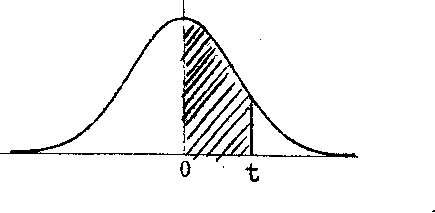
- •Introduction to adjustment calculus
- •Introduction to adjustment calculus (Third Corrected Edition)
- •Introduction
- •2. Fundamentals of the mathematical theory of probability
- •If d'cd; then p (d1) £ lf
- •Is called the mean (average) of the actual sample. We can show that m equals also to:
- •3.1.4 Variance of a Sample
- •Is called the variance (dispersion) the actual sample. The square root 2
- •In the interval [6,10] is nine. This number
- •VVII?I 0-0878'
- •In this case, the new histogram of the sample £ is shown in Figure 3.5.
- •Is usually called the r-th moment of the pdf (random variable); more precisely; the r-th moment of the pdf about zero. On the other hand, the r-th central moment of the pdf is given by:
- •3.2.4 Basic Postulate (Hypothesis) of Statistics, Testing
- •3.3.4 Covariance and Variance-Covariance Matrix
- •X and X of a multivariate X as
- •It is not difficult to see that the variance-covariance matrix can also be written in terms of the mathematical expectation as follows:
- •3.3.6 Mean and Variance-Covariance Matrix of a Multisample The mean of a multisample (3.48) is defined as
- •4.2 Random (Accidental) Errors
- •It should be noted that the term иrandom error" is used rather freely in practice.
- •In order to be able to use the tables of the standard normal
- •X, we first have to standardize X, I.E. To transform X to t using
- •Is a normally distributed random
- •4.10 Other Measures of Dispersion
- •The average or mean error a of the sample l is defined as
- •5. Least-squares principle
- •5.2 The Sample Mean as "The Maximum Probability Estimator"
- •5.4 Least-Sqaures Principle for Random Multivariate
- •In very much the same way as we postulated
- •The relationship between e and e for a mathematical model
- •6.4.4 Variance Covariance Matrix of the Mean of a Multisample
- •Itself and can be interpreted as a measure of confidence we have in the correctness of the mean £. Evidently, our confidence increases with the number of observations.
- •6.4.6 Parametric Adjustment
- •In this section, we are going to deal with the adjustment of the linear model (6.67), I.E.
- •It can be easily linearized by Taylor's series expansion, I.E.
- •In which we neglect the higher order terms. Putting ax for X-X , al for
- •The system of normal equations (6.76) has a solution X
- •In sections 6.4.2 and 6.4.3. In this case, the observation equations will be
- •In matrix form we can write
- •In metres.
- •6.4.7 Variance-Covariance Matrix of the Parametric Adjustment Solution Vector, Variance Factor and Weight Coefficient Matrix
- •I.E. We know the relative variances and covariances of the observations only. This means that we have to work with the weight matrix к£- 1
- •If we develop the quadratic form V pv 3) considering the observations l to be influenced by random errors only, we get an estimate к for the assumed factor к given by
- •Variance factor к plays. It can be regarded as the variance of unit
- •In metres,
- •Is satisfied. This can be verified by writing
- •Into a . О
- •6.U.10 Conditional Adjustment
- •In this section we are going to deal with the adjustment of the linear model (6.68), I.E.
- •For the adjustment, the above model is reformulated as:
- •Is not as straightforward, as it is in the parametric case (section 6.4.6)
- •VeRn VeRn
- •Into the above vector we get 0.0
- •0.0 In metres .
- •In metres.
- •Areas under the standard normal curve from 0 to t
- •Van der Waerden, b.L., 1969: Mathematical Statistics, Springer-Verlag.
Into the above vector we get 0.0
0.0 In metres .
-0.1
The weight matrix P of the observations is formulated as: (see example 6.17):
P = diag (0.25, 0.5, 0.5, 0.25, 0.5, 0.25) 6,6
and
P"1 = diag (k, 2, 2, k, 2, k). 6,6
The normal equations for the correlates К are
M К = W 3,3 3,1 3,1
where
м = |
В р" |
-1 Т В = |
12 |
k |
к |
3,3 |
|
|
|
|
|
|
|
|
k |
8 |
-2 |
|
|
|
k |
-2 |
8 |
inverting |
I М we get: |
|
|
|
|
|
|
0.15 |
-0.1 |
|
-0.1 |
-1 |
|
|
|
|
|
М |
= |
-0.1 |
0.2 |
|
0.1 |
3,3 |
|
|
|
|
|
|
|
-0.1 |
0.1 |
|
0.2 |
The solution for К is given Ъу
0.15
-0.1
-0.1
-0.1
0.2
0.1
-0.1
0.1
0.2
К = M~1W = 3,1
|
0.0 |
|
0.01 |
|
0.0 |
= |
-0.01 |
|
-0.1 e |
|
и -0.02 |
-1
т
- P
в
к
Г
V
6,1
m
0.00 0.02 0.02 -0.0U -0.0k
L o.ou _
and are again identical with the results of example 6.17, The adjusted observations will be.
|
L = L + |
V , i |
• e. |
|
|
|
|
|
|
|
|
6.16 |
|
0.00 |
|
|
12.57 |
|
0.02 |
ь |
|
6.Hi |
|
0.02 |
|
|
1.09 |
T |
-0.0U |
|
|
11.58 |
|
-0.0k |
к |
|
5.07 |
1 |
0.0k |
6.16 12.59
6ЛЗ
1.05 11. 5^
5.11
In metres.
Finally, to compute the estimated elevations of points
b, c, and d, i.e. , H^ and H , we will use the given
elevation H and the adjusted observations h..
a l
For instance;
= Ha + h^ = 0.0 + 1.05 = 1.05 m,
H = H + h = 0.0 + 6.16 = 6.16 m, с a 1
H. = H + hn = 0.0 + 12.59 = 12.59 m, d a 2
These are obviously identical with the corresponding results of the parametric adjustment.
Note again that when computing the estimates of the unknown parameters from the adjusted observations we can follow any route in computing them. They all lead to the same answer.
6.k.11 Variance-Covariance Matrix of the Conditional Adjustment Solution
The formula for the variance-covariance matrix of the adjusted
L
observations - the "result" of the conditional least squares adjustment -can be developed by applying the law of propagation of variance-covariance matrix (equation 6.15) on equation (6.113). In this equation, the matrices I,T,H are, obviously, fixed. Similarly, the vector С is considered as a vector of theoretically deduced, and therefore errorless, values, then will be zero. Hence, we get:
ч * <§> ч <§>T
= (i - T) Zj. (I - T)T
= Z- - IE- TT - TZ-I + TZ-TT. ir L L L
(6.115)
It is not difficult to see that both (IZ-T ) and (TZ-l) are square symmetric
L Jj
matrices, hence we can write:
Z; = Z- - 2TZ-I + TZ-TT L L L L
= z7 - tz- (21 - т ;.
(6.116)
Recalling, from equation 6.11U , that T = P"1 [BT(BP^b"1")] and
2 -1
knowing that P = a Z- , i.e.
о Jj
2 —1
Z- = a P , then by substituting these quantities into equation (6.1l6)
Li О
we get:
z; = a 2 p_1 - a 2 p"1 [bt(bp_1bt)_1b] p-1* L о о
к {21 - (p~1[bt(bp"1bt)"1b]t}
(6.ИТ)
Р —1 ф —1 ф —1 «Л
= о Р { I - 2[В (BP В ) В] Р +
+ ВТ (ВР"1ВТ)"1(ВР"1ВТ) (ВР_1ВТ)_1 БР-1}.
И"
м
и
-I
we
get finally
Noting
that
((bp~1bt)"1)t
=
(вр-3^)"1


? —1 ф 1 Ф 1 —1
Ел = а Р (I - В (BP В ) BP ) ♦
L о
(6.118)
Here, similar to the parametric adjustment, to obtain the estimated
л 2 2
variance-covariance matrix we use a instead of а , where:
о о
л 2 V PV _ V PV ао df " г
(6.119)
and we end up with
z; = о 2 (p_1 - p"1 bt (BP^B1)"1 bp"1) , (6.120)
L о
or,in an abbreviated form:
i: = а 2 (I - Т)]?""1 6) . (6-121)
L о
Analogous to the parametric adjustment, it also can be shown
that the estimate L assures the minimum trace of its variance-covariance
matrix E". Under the same assumptions as stated in section 6Л.8, the J_j
estimate L is also the most probable estimate of L.
Regarding the correlation between the adjusted observations
/Ч A
L, we can see that L will be uncorrelated if:(i) L is uncorrelated and (ii) the coefficient matrix В is orthogonal. If these two conditions are satisfied then T and P ^ will be diagonal matrices. On the other
л
hand, we can experience uncorrelated L even for some other general T and P.
Finally, we note that again the choice of the a priori variance factor a ^ does not influence the estimated E£ defined by equation (6Д21),
л
Example 6.22: Let us determine the var i anc е-соvari anc e matrix E" for the
L
conditional adjustment formulated in example 6.20. We have
ЛН - Eh.
v = —1 d. , i = 1, 2, 3,
1 ?d. 1
l l
and P = diag (~~, ~~).
3,3 1 2 a3
2 -1
Thus we get
а 2 vV Cah-ZS,)
0. - . — i
Ed.
1 1
The required variance-covariance matrix is given by equation 6.121, i.e.
e; = a 2 (i - T) P"1.
L о
-1 T -1
First we compute T = P В M B. We recall from example
6.20 that M""1 = 1/rd. , В = [1,1,1] 1,1 i 1 1,3
and P 1 = diag (d , d , d ).
3,3 ■
Hence,
dl |
0 |
0 |
0 |
d^ 2 |
0 |
0 |
0 |
d3 |
[ i—] [1, 1, 1] Zd,
and we obtain
^ _ 1
3,3 {i±
2 d3
Further we get (i - T) p"1
5 3
where a. = d, - -=-r~ i l Ed.
i = 1, 2, 3-
Finally we get
л л р ««."1
Е Г ' = а (I - Т) Р
з,зь
_ 2
(ДН - ?hi)
Ed. i l
4
3]
Example б»23: Let us determine the variance-covariance matrix for the conditionally adjusted levelling net of example 6.21. We have
VT = [0.00, 0.02, 0.02, -0.04, -0.0^, 0.0k] 1,6
in metres,
g 6 = diag [0.25, 0.5, 0.5, 0.25, 0.5, 0.25] 2
in m , and
r=df=n-u=6-3=3 Hence,
Am
A
л
Ш
.
V
PV
0.002
а
* s
—-—
о
f
r 3
= 0.00067 (unitless),
The required matrix is computed again from equation L
6.121 as
z; = а 2 (I - T) p""1
L о
6,6
where
P_1 = diag [k, 2, 2, 1», 2, h] 6,6
and T is computed from
T = 6,6
p-1 (btm-1b)
 Hence
}
Hence
}
(втм_1в) =
0.15 -0.1 0.1 -0.05 0 -0.05
-0.1 0.2 -0.1 -0.1 -0.1 0
0.1 -0.1 0.2 0 -0.1 0.1
-0.05 -0.1 0 0.15 0.1 0.05
0 -0.1 -0.1 0.1 0.2 -0.1
-0.05 0 0.1 0.05 -0.1 0.15
and: T = P-1 (BTM-1B) = 6,6
0.6 |
-оЛ |
O.k |
-0.2 |
0 |
-0.2 |
-0.2 |
0Л |
-0.2 |
-0.2 |
-0.2 |
0 |
0.2 |
-0.2 |
OA |
0 |
-0.2 |
0.2 |
-0.2 |
-оЛ |
0 |
0.6 |
O.k |
0.2 |
0 |
-0.2 |
-0.2. |
0.2. |
оЛ |
-0.2 |
-0.2 |
0 |
оЛ |
0.2 |
-оЛ |
0.6 |
Hence
(I - Т) Р"1 =
1.6 |
-0.8 |
0.8 |
-0.8 |
0 |
-0.8 |
-0.8 |
1.2 |
-ОД |
-0.8 |
-ОД |
0 |
0.8 |
-ОД |
1.2 |
0 |
-оД |
0.8 |
-0.8 |
-0.8 |
0 |
1.6 |
0.8 |
0.8 |
0 |
-ОД |
-ОД |
0.8 |
1.2 |
-0.8 |
-0.8 |
0 |
0.8 |
0.8 |
-0.8 |
2Д |
Finally we get
z; = a 2 (I - T) P_1 as L о
6,6
» 10
10.72 |
-5.36 |
5.36 |
-5.36 |
0 |
-5.36 |
-5.36 |
8.Oil |
-2.68 |
-5.36 |
-2.68 |
0 |
5.36 |
-2.68 |
8.Oil |
0 |
-2.68 |
5.36 |
-5.36 |
-5.36 |
0 |
10.72 |
5.36 |
5-36 |
0 |
-2.68 |
-2.68 |
5.36 |
8.0k |
-5.З6 |
-5.36 |
0 |
5.36 |
5.36 |
-5.36 |
16.08 |
in metres squared.
-U 2
By dropping the scalar 10 we get the results in cm .
The comments stated at the end of section 6Л.9 regarding
л 2 2
the value of a versus the assumed vialue of 1.0 for a о о
hold true here as well.
6.5 Exercise б
1. То determine the height h of a vail shown in the Figure, the
![]()
h![]() orizontal
distance
I
and
the
vertical
angle
9
were
observed
and
found
to
be:
orizontal
distance
I
and
the
vertical
angle
9
were
observed
and
found
to
be:
= 12°37f30f\ with S" = 10" ^ 0
£ = 85.3U m, with S~ = 2 cm.
Required: Compute the statistical estimate for h along with its RMS.
2. To determine the distance P P = с, which cannot be measured directly
due to the existence of some obstacle as shown in the Figure, the
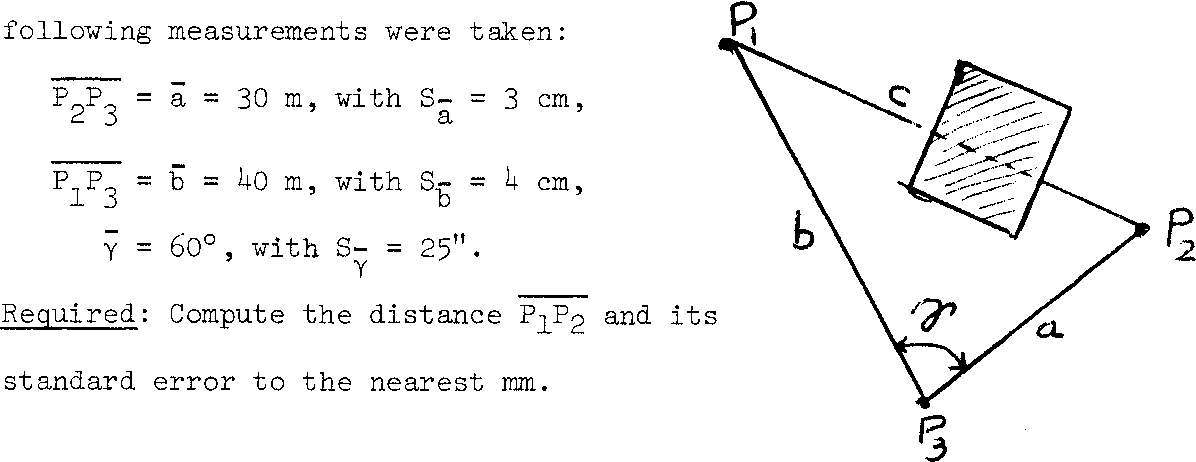
3. Determine the standard error of the estimated height h of the tower given in Problem number 9, Exercise k, section h.ll. Consider all the measured quantities, namely £, a, g and 0 to be uncorrelated.
k. From a point PQ in the x-y coordinate system shown below, a distance d = 5637.8 m and an azimuth T = Н9.987З grads (100 grads = 90 degrees) to a second point P^ were measured. The relative error of cL is 1.2 • lO"^. The RMS of T is 0.08 centigrads (l grad = 100 centigrads).

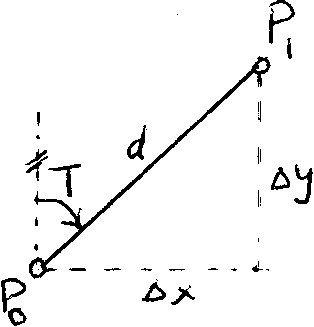
(i) The coordinate differences (Ax, Ay)
between points P and P_.
1 о 1
(ii) The variance-covariance matrix , where X = (Дх, Ay), in m . 'iii) The RMS of Ax and Ay respectively, (iv) The correlation coefficient between Ax and Ay.
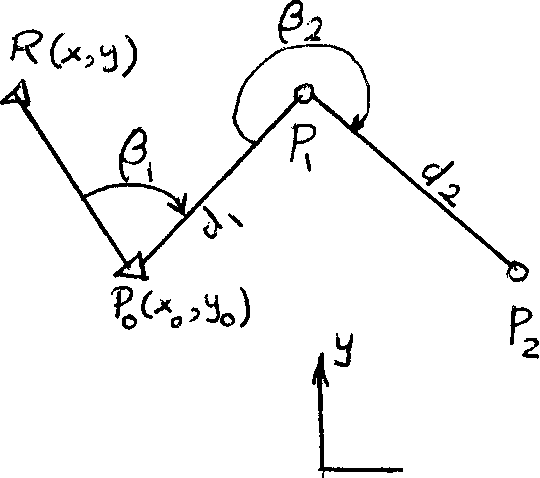
5. The shown traverse consists of two legs P^P^ and P^P^. The coordinates (xq, у ) of the initial point Pq as well as the (x, y) coordinates of the reference mark R are considered to be error-free (errorless) , i.e. fixed quantities. The measured quantities are the horizontal angles and 3^
and the horizontal distances d^ and d^ respectively. The available data are:
x |
= 100.0 m |
|
У = |
200 |
. 0 m , |
x о |
= 150.0 m |
» |
Yo = |
150 |
.0 m , |
h |
= 75° , |
with |
V |
3" |
Э |
2 |
= 270° , |
with |
%- |
2" |
5 |
h |
= 100 m |
and |
d2 = |
200 |
m. |
The standard error of the observed distance is to be calculated according to the formula :
Sr(cm) = 1.0 •(cm) + d(m) . 10 d
Required: Compute the following:
(i) The estimated coordinates (x-^, y^) of point along with their
associated variance-covariance matrix Z/" ч .
(х1э yx)
(ii) The estimated coordinates (X2, y2) °? point and their
variance-covariance matrix A N.
U2, y2)
Note that the coordinates are required to the nearest щ and the variances and covariances are required in cm 2
(iii) Discuss the correlation among the estimated coordinates x 9 y^, x2 and j2.
Having an intersection problem, as shown in the Figure э i.e.
observing the two horizontal angles 3 and a from the two known stations
P^ (x-^j y^) and P^ (x^, у ) in order to determine the (x, у) coordinates
of an unknown station P. Given: the following data:
2
cm,
5
cm
x
=
200.0
m
у
=
500.0
m



-0.5
x = 5^-6. U m
, Z,- - ) =
S-
=
3»
a
S-
=
2й
and
S =
0
.
Required: Compute the estimated (x, у) coordinates of the unknown
station P, in metres, and their associated variance-covariance matrix 2
Z, ч in cm (x, У)
Т. Consider problem number 1 of this exercise. Assume that the observed quantities I and 9 have got also non-random (systematic) errors of -1 cm and 5" respectively. Compute the expected total error in the derived height h in centimetres.
8. Determine the expected error in the sum of a hundred numbers in the following two cases:
(i) each individual number is to be rounded-off to three decimal places.
( ii)
each
individual
number
is
to
be
truncated
to
three
decimal
places.
ii)
each
individual
number
is
to
be
truncated
to
three
decimal
places.
Then compare and comment on the results.
9* To determine the height h of a tower, the technique shown in the Figure'" was proposed, in which, a, g, 9 and a are the quantities to be measured. The approxi- mate values of these quantities were obtained from a preliminary investigation and found to be: a = 60° , g =30° ,
0 = k5° and a = 100 m.
h
Providing that the horizontal angles a and g are to be measured with a precision of 2" (i.e. S~ = = 2"), what are the required precisions in measuring both the horizontal distance a and the vertical angle 9
(i.e. S- and S-) such that their contributions to the standard error S,
а у
of the derived height h - which is specified not to be worse than 2.^5 сш - will be the same.
10. Assume that the horizontal angles in a triangulation network are to be measured using two theodolites , "I" and"IIм , of different quality. These two theodolites were tested by measuring one particular angle several times, from which it was found that the standard deviation
of one observation, i.e. the standard deviation of the sample,observed
with theodolite "I" was S = 1V5 and with theodolite "II"
Ll
was S = 2!.?5. If it is specified that all the angles of the net-
2
work are required to have a standard deviation of the mean, i.e. S-, not worse than 07 5, how many times should we measure each angle when using theodolite number"l" and when using number "II"?
11. The following observations of the length of an iron bar in metres are made on a comparator:
3.28U, 3.302, 3.253, 3.273, 3.310, 3.321, 3.30*+, 3.295, 3.263, 3.270. Required: (i) the length of the bar (i.e. the mean) ; (ii) the RMS of one observation j (iii) the standard deviation of the mean.
12. The following table shows the means of the daily measurements of
the same distance I during a five day period, along with their
respective standard errors S~ .
i
Day |
Mon. |
Tues. |
Wed. |
Thurs. |
Fri. |
l± (m) |
101.01 |
100.00 |
99-97 |
99.96 |
100.02 |
i |
2 |
1 |
к |
5 |
3 |
Required: Compute the weighted mean of the distance £, say £, along with its associated RMS, i.e. S j.
Given a gravimetric network, as shown in the figure below, determine the gravity values g^ and g^ at points P^ and P^ respectively}
w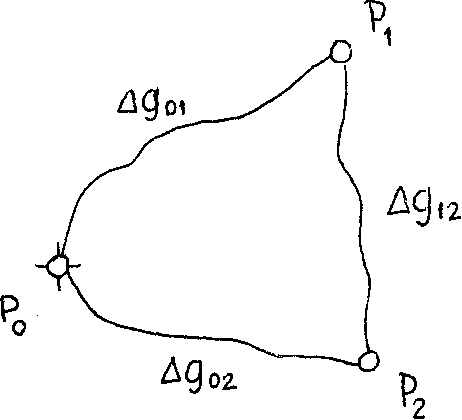 ith
their
variance-covariance
matrix.
The
gravity
ith
their
variance-covariance
matrix.
The
gravity
gQ = 979832.12 mgal at the initial point P^ is known.
The following table gives the observed gravity differences with their signs , along with the time needed for each observation.
Station |
Ag (mgal) |
ДТ (hr) |
|
From |
' To |
||
P 0 |
|
- 9.82 |
2.5 |
P2 |
po |
-27.78 |
1.5 |
Pl |
P2 |
+38 Л2 |
2.0 |
Assume that the observed differences Agfs are uncorrelated, and their variances are proportional to the corresponding time intervals AT.
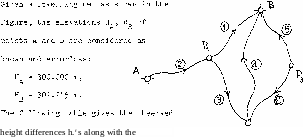 1 4
1 4
length I. of each section.
Section |
Station |
h. |
I. 1 (km) |
|
No. |
From |
To |
(m) |
|
1 |
|
В |
1.2U5. |
1.0 |
2 |
A |
pi |
0.990 |
0.5 |
3 |
pi |
P2 |
0.500 |
1.0 |
1+ |
P2 |
В |
0.751 |
1.0 |
5 |
P3 |
в |
1Л86 |
0.5 |
6 |
P3 |
P2 |
0.7^0 |
1.5 |
Note that the arrows in the given figure indicate the directions of
increasing elevations. The above observations are considered
2
uncorrelated with S~ proportional to
i
Required: Perform a parametric least squares adjustment of the above levelling net and find out the following:
(i) The estimated elevations H^, and of points P^ and P .
(ii) The adjusted values of the given six height differences.
a2
(iii) The estimated variance-factor and compare it with the assumed5
2
apriori variance factor S^; comment on the results.
(iv) The estimated variance-covariance matrix of X = (H ,H , H ).
X 1 <d j
15. Adjust the levelling net given in problem no. ih again by using the conditional method of adjustment. Replace the requirement no. iv by computing the estimated variance-covariance matrix of the adjusted height differences. Compare the results of the other three requirements with the corresponding results from the parametric adjustment.
l6. Two physical quantities Z and Y are assumed to satisfy the following linear model
Z = aY + g 9
where a and g are constants to be determined. The observations Y^ and Z^ obtained from an experiment are given in the following table.
Y |
1 |
3 |
k |
6 |
8 |
9 |
11 |
11* |
Z |
1 |
2 |
k |
h |
5 |
7 |
8 |
9 |
Assume that the Yfs are errorless, and the Z? s were observed with equal precision.
Required: Determine a and g which provide the best fitting line between Z and Y, in the least squares sense.
17» Solve problem No. l6 again, but this time consider the Z!s errorless , and the Y!s with equal variances. Compare the results for a and 3 with the corresponding results from problem No. 16.

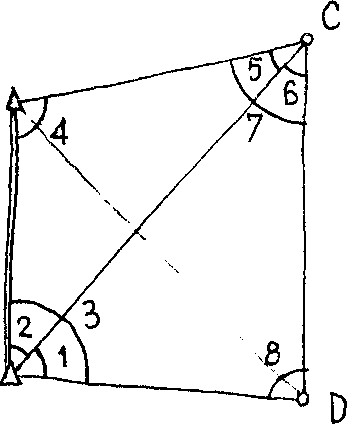
18. The given figure shows a triangulation network with fixed base AB = 2 km. The eight numbered angles in the Figure are all measured, each with a
different number n. of observations
i
as shown in the following table:
в
Angle Ко. |
п. i |
Mean |
value |
of the angle |
1 |
2 |
82° |
07' |
09'.'50 |
2 |
2 |
28 |
22 |
17-70 |
3 |
5 |
110 |
29 |
25.02 |
к |
3 |
125 |
53 |
33.67 |
5 |
2 |
25 |
kk |
09.30 |
6 |
2 |
29 |
19 |
17-50 |
7 |
5 |
55 |
03 |
29.32 |
8 |
3 |
68 |
33 |
32.33 |
Assume that all the measurements were done with the same instrument and under similar circumstances. (Hint: the weight of each angle will be proportional to the corresponding number of repetitions n^). Required: (i) Neglecting the spherical excess in this network, compute the distance CD using the adjusted values of the observed angles.
(ii) Considering the fixed base AB to be errorless, find the estimated relative error of the estimated length CD.
The given figure shows a braced quadrilateral ABCD in a triangulation network, in which all the directions marked by arrowheads were measured with the same precision. л
27
v26
32
>ИЗ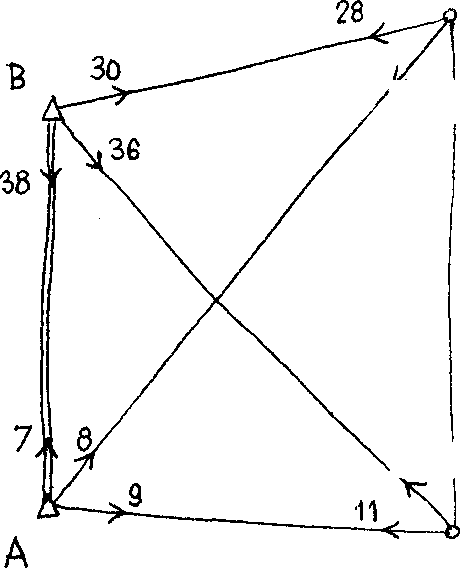

ЛАВС, e = 3V126 ,
AABD, e = lf.!556 )
ACBD, e = 3V085 ,
AACD, e = 17515 . The results of the direction observations are summarized in the following table.
D
|
|
|
|
|
|
Occupied |
Target |
Direction |
Observed Direction |
||
Station |
Station |
No. |
|
|
|
|
В |
7 |
00° |
00' |
00'.'00 |
A |
С |
8 |
91 |
30 |
30.35 |
|
D |
9 |
125 |
53 |
33.91 |
|
С |
30 |
00 |
00 |
00.00 |
В |
D |
36 |
28 |
22 |
17.26 |
|
A |
38 |
110 |
29 |
27.13 |
|
D |
26 |
00 |
00 |
00.00 |
С |
A |
27 |
29 |
19 |
17.52 |
|
В |
28 |
35 |
03 |
26.80 |
|
A |
11 |
00 |
00 |
00.00 |
D |
В |
12 |
35 |
07 |
. 29.00 |
|
С |
13 |
68 |
33 |
32.60 |
Required: (i) Perform a conditional adjustment and find out the adjusted values of the observed directions, along with their
estimated variance-covariance matrix .
L
(ii) Using LegendreT s theorem for the spherical triangle y i.e. by subtracting one third of the spherical excess from each adjusted angle and then solvirg the triangle as if it was a plane triangle compute the side CD from the known base AB and the adjusted directions. Then check the computed CD by following another route in its computation.
(iii) Compute the estimated relative error of the estimated length CD.
20. The given figure shows a triangulation network with two fixed (errorless) stations

E: 200.0 m, 0.0 m.
The Ik marked directions (with arrowheads) were observed with the same precision. The results of the observations are tabulated below.
Occupied |
Target |
Direction |
Observed |
Directions |
|
Station |
Station |
No. |
|
|
|
л |
В |
1 |
00° |
00 |
OO'.'O |
ii |
С |
2 |
60 |
00 |
10.0 |
|
D |
3 |
00 |
00 |
00.0 |
В |
С |
h |
60 |
00 |
05-0 |
|
A |
5 |
119 |
59 |
50.0 |
|
A |
6 |
00 |
00 |
00.0 |
с |
В |
1 |
59 |
59 |
55-0 |
|
D |
8 |
120 |
00 |
00.0 |
|
e |
9 |
180 |
00 |
05.0 |
|
e |
10 |
00 |
00 |
00.0 |
D |
С |
11 |
59 |
59 |
1+5.0 |
|
В |
12 |
119 |
59 |
55.0 |
|
A |
13 |
00 |
00 |
00.0 |
Ji |
D |
lU |
60 |
00 |
15.0 |
Required: Prepare the input for a computer program performing a parametric least squares adjustment using the directions (not the angles) to estimate the unknown coordinates of points В, С and D by-providing the following:
(i) The number of unknown parameters and the number of degrees of freedom.
(ii) The non-linear mathematical model. (iii) The approximate values for the ,x, у coordinates of points B,C,D.
(iv) The linearized form of the mathematical model, i.e. V = AAX-AL, giving the symbolic elements of the vectors V and AX and the numerical values of the elements of the design matrix A and the vector AL.
(v) Construct the variance-covariance matrix E - of the ohser-vat ions assuming the standard errors in directions to equal 2".
APPENDIX I
Assumptions for and Derivation of the Gaussian PDF
The derivation of the Gaussian PDF presented here is. due to G.H.L. Hagen (l837)• The first formulation of the normal law, however,originates with De Moivre (1733).
(i) Let us assume that m independent physical causes are influ- encing the measurement. Let each cause contribute an elementary error either +A or -Л towards the overall error e. Any value of e can thus be expressed as a combination (there are n = 2m such combinations) of m elementary errors + Д. We note first that the spaa of e is <-mA, mA>. Further, we realize that e can attain only a value of an integral multiple of A. It is not difficult to see that any two adjacent values of e differ by 2A since one is obtained from the other by replacing -A by +A and vice- versa. Dividing the range of e
Ra (e) = mA - (-mA) = 2mA by the step of e, i.e. 2A, we discover that e can attain any of the following m + 1 values
ei ~ " Ш)Д ' i = 0, 1, ... т. (1-1)
corresponding to particular distinguishable combinations of the m elementary errors.
(ii) Let us regard now the set D of all permissible values of e
the probability space of the random sample consisting of all the 2m combinations e. Obviously, many of the 2Ш combinations have the same values, because there are only m + 1 different values available. The counts, c^, of the individual values (see section 3.1.1) can be computed using the combined probability (see section 2.3):
c_
=
(m}
щ
m
(m-l) (ш-2)
...
ОачИ-l)
=
J
j/
n
j.
(l-2)
11 i
(i-1) (i-2) ...
1 j=m-i+l
j=l
The actual probability of any value is then given by
P(.e ) =!l= ф/2ш , (1-3)
1 n 1
(see section 3.1.2).
(iii) The above formula describes the actual PDF of our sample e in the discrete probability space D. Since our ultimate aim is to derive the analytic expression for the "corresponding" (we shall see later what is meant by corresponding) continuous PDF, we want to be able to express P as a function of rather that i. The easiest way to do it is to use the finite differences.
Let us;.define
6P(e.) = P(e.) - P(eiel)
and we get from equation (1-3)
бр(е.) = ф/2Ш - (Д)/2т
т
= (Ш)/2т (1 - -4-г). 1 т-1+1
Obviously, the ratio 6Р (е^)/Р(е^) is then given by
6P(ei)/P(ei) = 1 - i/(m-i+l). On the other hand, i can Ъе expressed as a function of from equation (I-D
2i - m = e^/A
or 1
1 = 2 ^e±/A + m)•
Renoting <5e = 2A and substituting for i in equation (i-U) we obtain
6P(e) = _ c/6£ + m/2 P(e) m - e/бе- m/2 + 1
= 1 + m/2 - в/б£ - e/6e- m/2 1 + m/2 - e/6e
_ 1 - 2e/6e = 2e - 6g
1 + m/2 - e/бе (l + m/2) 6e - e
(iv) The next step in the development is to convert the discrete PDF, P(e), to a continuous PDF, i.e. to derive the "corresponding" continuous PDF. The "corresponding" PDF is assumed to be the PDF of such a variable e which is defined the same way as the- discrete e in (i) with the exception that m is let to grow beyond all limits, i.e. m -> °°. By letting m grow we would obtain infinitely large values of e (see equation (i-l)). This would contradict our experience teaching us that the errors are always finite in value. Hence, we have to adopt another assumption and that is that as m grows to infinity, the absolute value of elementary error A grows to zero, making the product mA in equation (I-i) always finite.
Accepting these two assumptions we can write the finite difference equation as
6P(e) . 28 - бе
lim ——— = -» .lim ————————
P<e> (l+m/2) бе - e (l~5)
ш—> oo m 00
6e -> 0 Se 0
which is nothing else hut an ordinary differential equation for the continuous PDF P(e). It can thus he rewritten as
d P(e) 2e - de
P(e) (1 + m/2) de - e
To simplify the solution of this differential equation let us multiply
both the numerator and denominator of the right hand side by de and assume 2
that mde " is constant We further assume
2 2
de << ede << mde = С .
Then we can write
P " С/2 С
dP 2 ede k
ede . (1-6)
(v) We can now finally solve the differential equation. It is solvable by direct integration and we get
f— = - ede + const,
. k e2 in P = - ~ — + const.
Denoting the integration constant by Лn К we finally obtain
P = К exp (~2e2/C). (i-T)
The question now arises whether we are free to regard both К and С as two independent parameters of the above PDF. We know that the basic equation for a PDF, i.e
/ °° P(e) de = 1 (1-8)
™.oo
has to be satisfied. Substituting for P into the basic equation we get
f P(e) de = / К exp (-2e2/C) de =
К / exp (-2e2/C) de = 1
and К = 1 / / exp (-2e2/C) de
Hence the answer is that К must not be regarded as an independent parameter. It is a function of С and can be evaluated by solving the integral above. We obtain
00
/ exp (-2e2/C) de = 2 / °° exp (-2e2/C) de = / — (1-9)
m 0
and К ~ / . (1-10)
Стг
The Gaussian PDF can then be written as
P(e) = G (C;e) = exp (-2e2/C) (i-ll)
and we can see that it is a one-parametric PDF.
APPENDIX II - A
' ■* ORDINATES OF THE STANDARD NORMAL CURVE . Y = exp .(-, —) V2* 2 |
|
Y. j |
N. |
° t |
|||
t |
0 |
1 |
2 |
3 |
•■• 4 |
5 |
6 |
7 |
8 |
9 |
O.Q |
.3989 |
.3989 |
.3989 |
.3988 |
.3986 |
.3984 |
.3982 |
.3980 |
.3977 |
.3973 |
од |
„3970 |
.3965 |
.3961 |
.3956 |
.3951 |
.3945 |
.3939 |
.3932 |
.3925 |
.3918 |
0.2 |
.3910 |
.3902 |
.3894 |
.3885 |
.3876 |
.3867 |
.3857 |
.3847 |
.3836 |
.3825 |
0.3 |
.3814 |
.3S02 |
.3790 |
.377? |
.3765 |
.3752 |
.3739 |
.3725 |
.3712 |
.3697 |
0,4 |
.3683 |
.3668 |
.3653 |
.3637 |
.3621 |
.3605 |
.3589 |
.3572 |
.3555 |
.3538 |
0.5 |
. .3521 |
.3503 |
.3485 |
.3467 |
.3448 |
.3429 |
.3410 |
.3391 |
.3372 |
.3352 |
0.6 |
.3332 |
.3312 |
.3292 |
.3271 |
.3251 |
.3230 |
.3209 |
.3187 |
.3166 |
.3144 |
0.7 |
.3123 |
.3101 |
.3079 |
.3056 |
.3034 |
.3011 |
.2989 |
.2966 |
.2943 |
.2920 |
0.8 |
.28.97 |
.2874 |
.2850 |
.2827 |
.2803 |
.2780 |
.2756 |
.2732 |
.2709 |
.2685 |
0.9 |
.2661 |
.2637 |
.2613 |
.2589 |
.2565 |
.2541 |
.2516 |
.2492 |
.2468 |
.2444 |
1.0 |
.2420 |
.2396 |
.2371 |
.2347 |
.2323 |
.2299 |
.2275 |
.2251 |
.2227 |
.2203 |
1.1 |
.2179 |
.2155 |
.2131 |
.2107 |
.2083 |
.2059 |
.2036 |
.2012 |
.1989 |
.1965 |
1.2 |
Л942 |
.1919 |
.1895 |
.1872 |
.1849 |
.1826 |
.1804 |
.1781 |
.1758 |
.1736 |
1.3 |
.1714 |
.1691 |
.1669 |
.1647 |
.1626 |
.1604 |
.1582 |
.1561 |
.1539 |
.1518 |
1.4 |
.1497 |
.1476 |
.1456 |
.1435 |
.1415 |
.1394 |
.1374 |
.1354 |
.1334 |
.1315 |
1.5 |
.1295 |
.1276 |
.1257 |
.1238 |
.1219 |
.1200 |
.1182 |
.1163 |
.1145 |
.1127 |
1.6 |
.1109 |
.1092 |
.1074 |
.1057 |
.1040 |
.1023 |
.1006 |
.0989 |
.0973 |
.0957 |
1.7 |
.0940 |
.0925 |
.0909 |
.0893 |
.0878 |
.0863 |
.0848 |
.0833 |
.0818 |
.0804 |
1.8 |
.0790 |
.0775 |
.0761 |
' .0748 |
.0734 |
.0721 |
.0707 |
.0694 |
.0681 |
.0669 |
1.9 |
.0658 • |
.0644 |
.0632 |
.0620 |
.0608 |
.0596 |
.0584 |
.0573 |
.0562 |
.0551 |
2.0 |
.0540 |
.0529 |
.0519 |
.0508 |
.0498 |
.0488 |
.0478 |
.0468 |
.0459 |
.0449 |
2.1 |
.0440 |
.0431 |
.0422 |
.0413 |
.0404 |
.0396 |
.0387 |
.0379 |
.0371 |
,0363 |
2.2 |
.0355 |
.0347 |
.0339 |
.0332 |
.0325 |
.0317 |
.0310 |
.0303 |
.0297 |
.0290 |
2.3 |
.0283 |
.0277 |
.0270 |
.0264 |
.0258 |
.0252 |
.0246 |
.0241 |
.0235 |
.0229 |
2.4 |
.0224 |
.0219 |
.0213 |
.0208 |
.0203 |
.0198 |
.0194 |
.0189 |
.0184 |
.0180 |
2.5 |
.0175 |
.0171 |
.0167 |
.0163 |
.0158 |
.0154 |
.0151 |
.0147 |
.0143 |
.0139 |
2.6 |
.0136 |
.0132 |
.0129 |
.0126 |
.0122 |
.0119 |
.0116 |
.0113 |
.0110 |
.0107 |
2.7 |
.0104 |
.0101 |
.0099 |
.0096 |
.0093 |
.0091 |
.0088. |
.0086 |
.0084 |
.0081 |
2.8 |
.0079 |
.0077 |
.0075 |
.0073 |
.0071 |
.0069 |
.0067 |
.0065 |
.0063 |
.0061 |
2.9 |
.0060 |
.0058 |
.0056 |
.0055 |
.0053 |
.0051 |
.0050 |
.0048 |
.0047 |
.0046 |
3.0 |
.0044 |
.0043 |
.0042 |
.0040 |
.0039 |
.0038 |
.0037 |
.0036 |
.0035 |
.0034 |
3.1 |
.0033 |
.0032 |
.0031 |
.0030 |
.0029 |
.0028 |
.0027 |
.0026 |
.0025 |
.0025 |
. 3.2 |
.0024 |
.0023 |
.0022 |
.0022 |
.0021 |
.0020 |
.0020 |
.0019 |
.0018 |
.0018 |
3.3 |
.0017 |
.0017 |
.0016 |
.0016 |
.0015 |
.0015 |
.0014 |
.0014 |
.0013 |
.0013 |
3.4 |
.0012 |
.0012 |
.0012 |
.0011 |
.0011 |
.0010 |
.0010 |
.0010 |
.0009 |
.0009 |
3.5 |
.0009 |
.0008 |
.0008 |
.0008 |
.0008 |
.0007 |
.0007 |
.0007 |
.0007 |
.0006 |
3.6 |
.0006 |
.0006 |
.0006 |
.0005 |
.0005 |
.0005 |
.0005 |
.0005 |
.0005 |
.0004 |
3.7 |
.0004 |
.0004 |
.0004 |
.0004 |
.0004 |
.0004 |
.0003 |
.0003 |
.0003 |
.0003 |
3.8 |
.0003 |
.0003 |
.0003 |
.0003 |
.0003 |
.0002 |
.0002 |
.0002 |
.0002 |
.0002 |
3.9 |
.0002 |
.0002 |
.0002 |
.0002 |
.0002 |
.0002 |
.0002 |
.0002 |
.0001 |
.0001 |
239
APPENDIX
II-B

t |
0 |
1 |
2 |
3 |
4 |
5 |
6 |
7 |
8 |
9 |
0.0 |
.5000 |
.5040 |
.5080 |
.5120 |
.5160 |
.5199 |
.5239 |
.5279 |
.5319 |
.5359 |
0.1 |
.5398 |
.5438 |
.5478 |
.5517 |
.5557 |
.5596 |
.5636 |
.5675 |
.5714 |
.5754 |
0.2 |
.5793 |
.5832 |
.5871 |
.5910 |
.5948 |
.5987 |
.6026 |
.6064 |
.6103 |
.6141 |
0.3 |
.6179 |
.6217 |
.6255 |
.6293 |
.6331 |
.6368 |
.6406 |
.6443 |
.6480 |
.6517 |
0.4 |
.6554 |
,6591 |
.6628 |
.6664 |
.6700 |
.6736 |
.6772 |
.6808 |
.6844 |
.6879 |
0.5 |
.6915 |
.6950 |
.6985 |
.7019 |
.7054 |
.7088 |
.7123 |
.7157 |
.7190 |
.7224 |
0.6 |
.7258 |
.7291 |
.7324 |
.7357 |
.7389 |
.7422 |
.7454 |
.7486 |
.7518 |
.7549 |
0.7 |
.7580 |
.7612 |
.7642 |
.7673 |
.7704 |
.7734 |
.7764 |
.7794 |
.7823 |
.7852 |
0.8 |
.7881 |
.7910 |
.7939 |
.7967 |
.7996 |
.8023 |
.8051 |
.8078 |
.8106 |
.8133 |
0,9 |
.8159 |
.8186 |
.8212 |
.8238 |
.8264 |
.8289 |
.8315 |
.8340 |
.8365 |
.8389 |
1.0 |
.8413 |
.8438 |
.8461 |
.8485 |
.8508 |
.8531 |
.8554 |
.8577 |
.8599 |
.8621 |
1.1 |
.8643 |
.8665 |
.8686 |
.8708 |
.8729 |
.8749 |
.8770 |
.8790 |
.8810 |
.8830 |
1.2 |
.8849 |
.8869 |
.8888 |
.8907 |
.8925 |
.8944 |
.8962 |
.8980 |
.8997 |
.9015 |
1.3 |
,9032 |
.9049 |
.9066 |
.9082 |
.9099 |
.9115 |
.9131 |
.9147 |
.9162 |
.9177 |
Г.4 |
.9192 |
.9207 |
.9222 |
.9236 |
.9251 |
.9265 |
.9279 |
.9292 |
.9306 |
.9319 |
1.5 |
.9332 |
.9345 |
.9357 |
.9370 |
.9382 |
.9394 |
.9406 |
.9418 |
.9429 |
.9441 |
1.6 |
.9452 |
.9463 |
.9474 |
.9484 |
.9495 |
.9505 |
.9515 |
.9525 |
.9535 |
.9545 |
1.7 |
.9554 |
.9564 |
.9573 |
.9582 |
.9591 |
.9599 |
.9608 |
.9616 |
Л625 |
.9633 |
1.8 |
.9641 |
.9649 |
.9656 |
.9664 |
.9671 |
.9678 |
.9686 |
.9693 |
.9699 |
.9706 |
1.9 |
.9713 |
.9719 |
.9726 |
.9732 |
.9738 |
.9744 |
.9750 |
.9756 |
.9761 |
.9767 |
2.0 |
. .9772 |
.9778 |
.9783 |
.9788 |
.9793 |
.9798 |
.9803 |
.9808 |
.9812 |
.9817 |
2.1 |
.9821 |
.9826 |
.9830 |
.9834 |
.9838 |
.9842 |
.9846 |
.9850 |
.9854 |
.9857 |
2.2 |
.9861 |
.9864 |
.9868 |
.9871 |
.9875 |
.9878 |
.9881 |
.9884 |
.9887 |
.9890 |
2.3 |
.9893 |
.9896 |
.9898 |
.9901 |
.9904 |
.9906 |
.9909 |
.9911 |
.9913 |
.9916 |
2.4 |
.9918 |
.9920 |
.9922 |
.9925 |
.9927 |
.9929 |
.9931 |
.9932 |
.9934 |
.9936 |
2.5 |
.9938 |
.9940 |
.9941 |
.9943 |
.9945 |
.9946 |
.9948 |
.9949 |
.9951 |
.9952 |
2.6 |
.9953 |
.9955 |
.9956 |
.9957 |
.9959 |
.9960 |
.9961 |
.9962 |
.9963 |
.9964 |
2.7 |
.9965 |
.9966 |
.9967 |
.9968 |
.9969 |
.9970 |
.9971 |
.9972 |
.'9973 |
.9974 |
2.8 |
.9974 |
.9975 |
.9976 |
.9977 |
.9977 |
.9978 |
.9979 |
.9979 |
.9980 |
.9981 |
2.9 |
.9981 |
.9982 |
.9982 |
.9983 |
.9984 |
.9984 |
.9985 |
.9985 |
.9986 |
.9986 |
3.0 , |
.9987 |
.9987 |
.9987 |
.9988 |
.9988 |
.9989 |
.9989 |
.9989 |
.9990 |
.9990 |
3.1 |
.9990 |
.9991 |
.9991 |
.9991 |
.9992 |
.9992 |
.9992 |
.9992 |
.9993 |
.9993 |
3.2 |
.9993 |
.9993 |
.9994 |
.9994 |
.9994 |
.9994 |
.9994 |
.9995 |
.9995 |
.9995 |
3.3 |
.9995 |
.9995 |
.9995 |
.9996 |
.9996 |
.9996 |
.9996 |
.9996 |
.9996 |
.9997 |
3.4 |
.9997 |
.9997 |
.9997 |
.9997 |
.9997 |
.9997 |
.9997 |
.9997 |
.9997 |
.9998 |
3.5 |
.9998 |
-.9998 |
.9998 |
.9998 |
.9998 |
.9998 |
.9998 |
.9998 |
.9998 |
.9998 |
3.6 |
.9998 |
.9998 |
.9999 |
.9999 |
.9999 |
.9999 |
.9999 |
.9999 |
.9999 |
.9999 |
3.7 |
.9999 |
.9999 |
.9999 |
.9999 |
.9999 |
.9999 |
.9999 |
.9999 |
.9999 |
.9999 |
3.8 |
.9999 |
.9999 |
.9999 |
.9999 |
.9999 |
.9999 |
.9999 |
.9999 |
.9999 |
.9999 |
3.9 |
1.0000 |
1.0000 |
1.0000 |
1.0000 |
1.0000 |
1.0000 |
1.0000 |
1.0000 |
1.0000 |
1.0000 |
APPENDIX II - С

